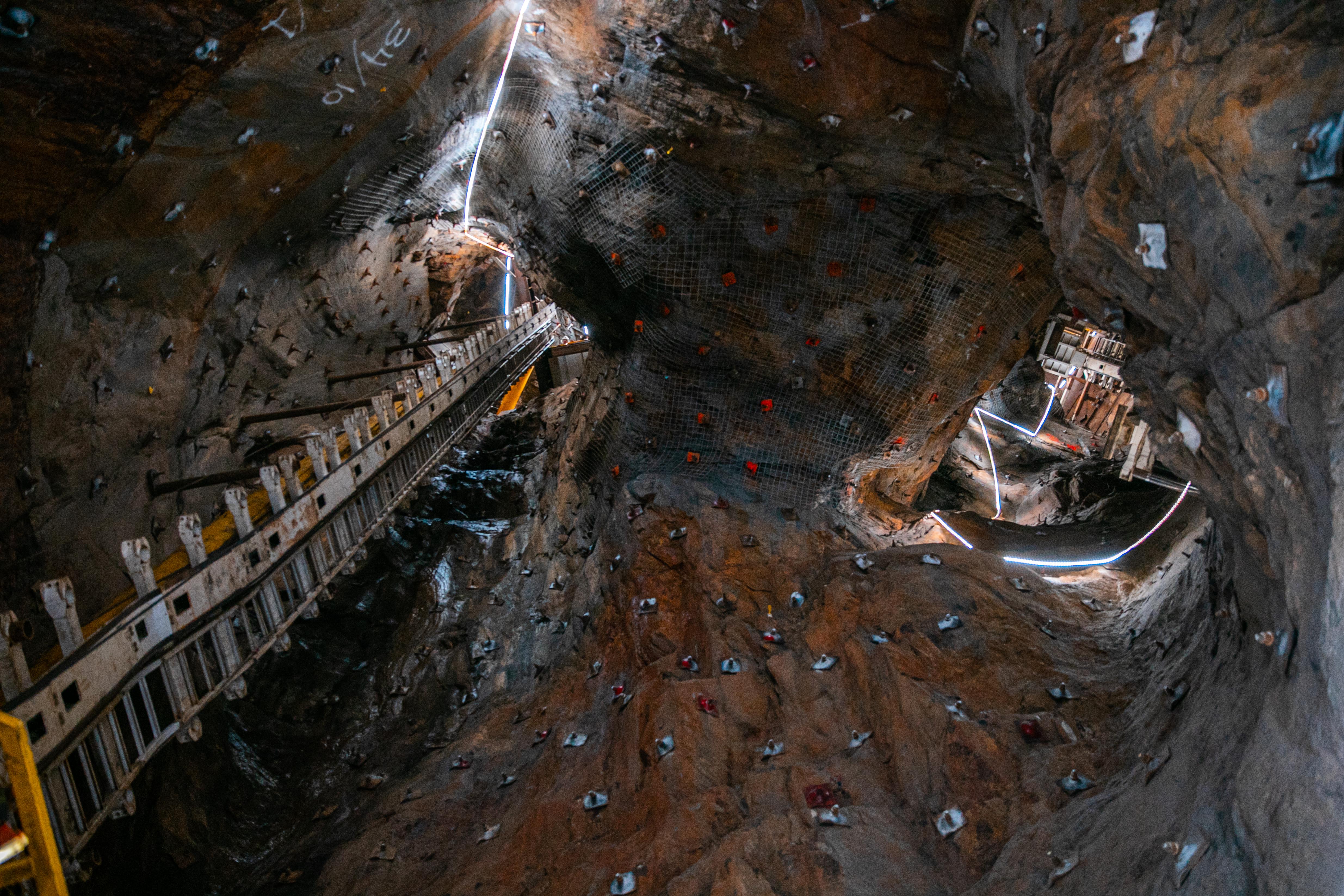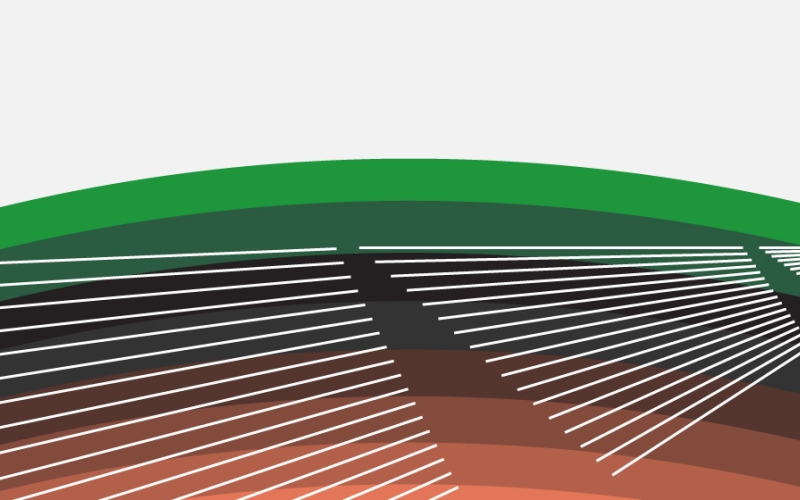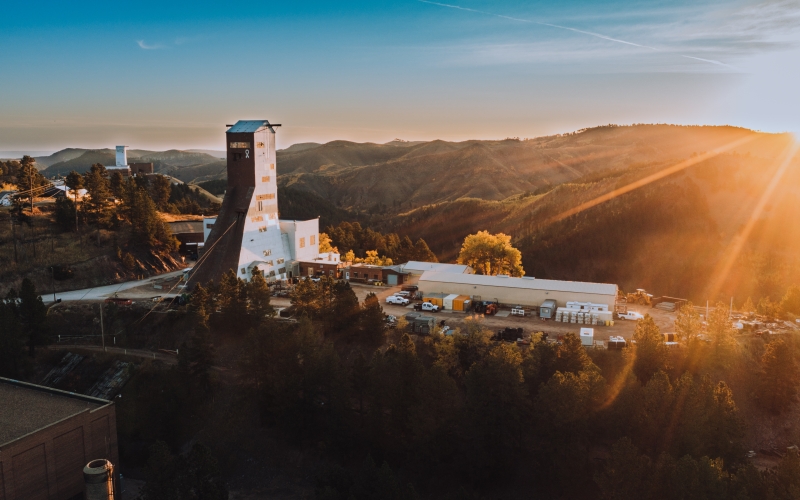
Matthew Kapust
In early 2020, Matthew Kapust stood nearly 5,000 feet beneath the surface at Sanford Underground Research Facility (SURF), camera in hand, looking up.
That day, Kapust was documenting progress on the reopening of a pair of underground ore passes. Throughout the facility’s history, this space had been recreated innumerable times. The ore passes were originally drilled by Homestake Gold Mine in the 1970s. This created chutes for rock to be transported between levels. For decades, rock tumbled through on its way to be hoisted, crushed and processed for gold extraction. When the mine closed in 2002, rising water clogged the passes with residual rock and sand. In 2020, the ore passes were being reopened to use during excavation for the Long-Baseline Neutrino Facility (LBNF), which will house the Deep Underground Neutrino Experiment (DUNE).
At the time, Kapust knew the space would continue to change. Even the ground he stood on would soon be excavated as crews continued clearing the ore passes.
Photographing ever-changing underground spaces is not a new challenge for Kapust. A photographer at SURF since 2009, Kapust views photography as a tool for documenting these liminal spaces and sharing their transformation with the public. Kapust’s science and engineering photography has appeared in USA Today, The New York Times, Popular Science and Physics World. Recently, his photography of the ore passes was selected as a finalist for the Engineering News-Record’s (ENR) 2020 photo contest.
“Matt’s work has been featured in national and international newspapers and magazines. It’s a testament to his expertise in capturing moments in time. And, perhaps more importantly, it’s a testament to his creativity and his desire to tell stories from a different perspective,” said Constance Walter, director of communications at SURF. “I’m very proud of the work he does and the way he represents SURF.”
We caught up with Kapust to learn more about his career as a photographer and role as Creative Services Supervisor at SURF. The interview has been edited and condensed for clarity.
SURF: Congratulations on your photo being selected as a finalist in the ERN’s 2020 photo contest. Looking at the photo now, can you describe what we are seeing?
Kapust: In the photo, you see where two underground ore passes connect. On the left-hand side is the Ross Ore Pass, and on the right is the 6 Winze Ore Pass. Historically, rock would get dumped down these passes to rock handlers on the 5000 Level then loaded onto the skips and brought to the surface. That’s what they will be used for again during excavation for the Long-Baseline Neutrino Facility.
The contractor [Kiewit-Alberici Joint Venture] has those wonderful rope lights they install everywhere underground and it really makes a photographer’s job quite easy.

How did you get to where you were standing to take this photo?
Kapust: We took the cage down the Ross Shaft. When we got to the 4850 Level, and stepped off the Ross Cage, we could see the ore pass to the left. It’s a big hole—covered and marked off for safety—but it’s still a big open hole.
In the photo, on the left, you can see a track, which is used to haul people and materials up and down into the work area at the bottom of the ore passes. The conveyance is big enough for two people to ride down at a time—you have to ride on your knees. The ride down was kind of disorienting, because the track follows the contours of the irregular shape of the rock. The only way I can describe it is like a roller coaster almost—a really slow-moving roller coaster that tilts you just a bit back and forth. So yeah, it's kind of weird going down there.
SURF: How has the facility changed since you began working here in 2009?
Kapust: When I first got here, we were riding down the Ross Cage, which is actually the cage that's in the Visitor Center right now. But, if you talk to people who have been here a long time, you’ll know that that cage was actually originally the Yates Cage. Each piece of this place has its own history, as you can see. But that was the first cage I ever rode down.
I didn’t go underground until the 4850 Level had been dewatered. When I first saw it, it was a mess. Sludge—slick, red, slimy mud—everywhere. You had to walk through water that was sometimes up past the top of your muck boots. The underground wasn’t ventilated super well yet, so the air was hot, humid and foggy. We had to acclimate our cameras to the heat near the shaft heaters on the surface and then hope they would stay warm on the trip down the shaft. Underground, we had to keep de-fogging them. It just took a long time to do anything.
Once they got all the 4850 Level cleaned up, that was a transformation. The ventilation was better, the dust settled down, and you could start using your camera gear easily again.
Then they began the first projects underground. Taking apart the Davis Experiment water tank and refurbishing that area. Excavating the space where the Majorana Demonstrator is now. Refurbishing the space where the electro-forming lab was. That was the first lab that came online. That was really cool to see a modular cleanroom built underground for electro-forming.
SURF: When did you first get into photography?
Kapust: Well, actually, I got into Photoshop first, creating photo composites and practicing photo manipulation and just toying with all you can do in programs like these. I consider myself more of a gearhead. I like playing with the toys, learning new ways to create. That's why I like working at SURF so much. Here, our projects combine all these different parts—graphic design and writing and photos and video and storytelling. Those are the most fun projects to me, when you combine different forms of art.
Although photography is one of the parts of my job that I enjoy the most, it’s always about providing a way for others to visualize what’s happening at Sanford Lab.
SURF: Is there something you haven’t photographed yet that you want to?
Kapust: I’d like to photograph more spaces in 3D and create 360-degree virtual reality—I think that would be the next frontier of capturing different spaces in the lab.
SURF: How does photography help tell the story of SURF?
Kapust: To communicate a facility of this scope to the greatest number of people, I think you have to use photography. The number of people who come underground has always been limited by how many people can fit on the cage, our underground headcount limit and the fact that some underground areas have active experiments or construction projects. And now with COVID-19, the number of people visiting is even lower.
And, even if you have seen a space in person, photography has a nice way of revealing a space in a new way. For example, you can use long exposures to light up large underground spaces. Typically, where you’re down there, all you have is a cap light or a work light. With those light sources, you can’t really see the whole picture. So, later, when you’ve created a long-exposure photo, you can see the whole space in completion for the first time.



